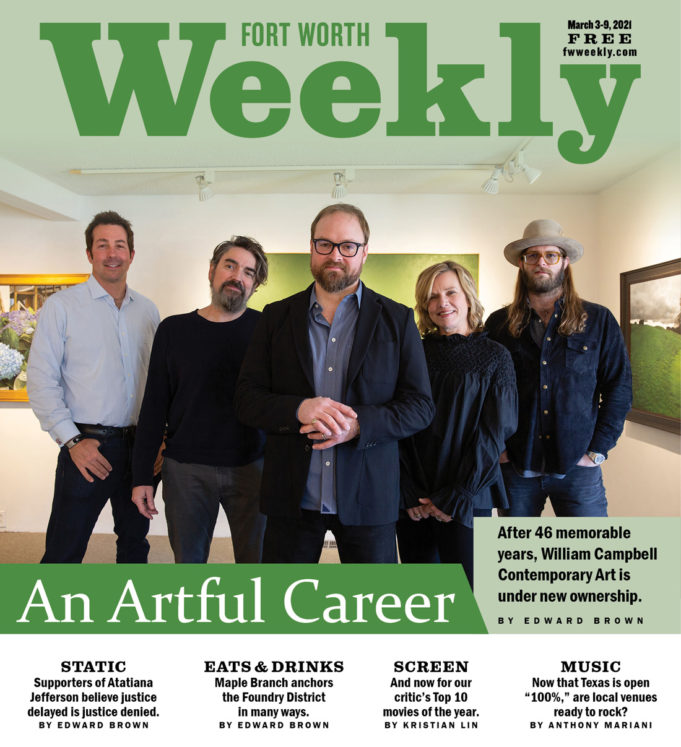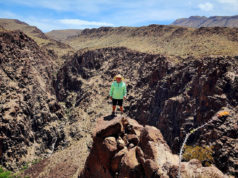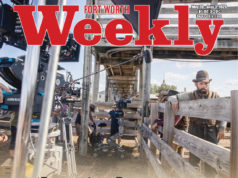Bill and Pam Campbell, founders and longtime owners of William Campbell Contemporary Art, said many aspects of their career were unexpected.
“When we opened our gallery, we were a bit naive about it,” Pam said. “I don’t know if that was a good or a bad thing.”
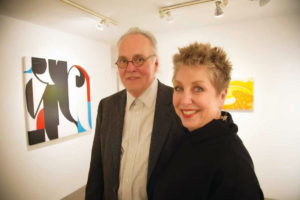
Bill said he had no idea that the gallery would thrive for 46 years in the often unpredictable contemporary art market. They were so busy year to year, he said, that the idea of ever retiring (or reflecting on decades of work in the gallery business) always seemed like a distant idea.
This job keeps you “planning a year or two ahead,” he said. “Time goes by pretty fast. You have so much in front of you on a daily basis that if you sit and dream you will miss the boat.”
The option of selling the Arlington Heights-based gallery became a serious possibility when a group of five partners — Peeler Howell, Tim Locke, Jadz Pate, Clayton Snodgrass, and J.W. Wilson — offered to buy the business.
Howell, who has worked as the gallery manager at William Campbell Contemporary Art for the past three years, said part of his motivation to buy a stake in the business was to preserve the gallery’s legacy. The initial conversation happened over coffee between Howell and Wilson.
“We wanted to continue doing what Bill and Pam had done so well for 46 years,” Howell said.
The friends sat down with Bill and Pam in April to discuss the possibility of handing over ownership to the five partners. The Campbells said they felt honored that the prospective owners wanted to keep the gallery’s name.
“I’ve known Bill and Pam for years,” Wilson said. “I asked Pam for advice on opening an art gallery. That led to Fort Works Art, which I’m no longer a part of. I’ve always admired Bill and Pam for their longevity.”
After so many decades in the art business, Bill said he and his wife didn’t have an “exit strategy” for leaving the gallery, although they had always wanted the gallery to stay open even after their departure.
The offer to buy the gallery came as a “total surprise to us,” Bill said. Howell and Wilson had “great ideas of what they wanted to do. They wanted to continue the name, which I think was smart.”
Bill and Pam said it felt like the right time to pass the gallery to new, younger owners.
“I felt a little like I’ve run out of steam as far as pushing it forward,” Bill said. “A lot of it had to do with the fact that we and our artists have grown older together. The audience was getting older, too, and smaller. New blood is a positive push, in our opinion.”
Ownership of the gallery was officially signed over in December, but Howell and Wilson said the transition has been gradual and ongoing. The new owners are planning minor cosmetic upgrades, but Howell said the business will largely retain the look and feel that customers are familiar with. The gallery’s roster of 40 artists (who mainly sell paintings or works on paper) is evenly split between Texas and national artists, Peeler said. The gallery represents a handful of international artists as well, he added.
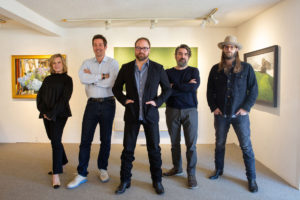
Photo courtesy of Collin Howell.
“We don’t want to get rid of anyone we currently represent for a number of reasons,” Howell said. “The main reason being we love the artwork. There is room to add some new artists. We’re looking at three of four artists who are more contemporary but not so far out that there isn’t an aesthetic cohesiveness to their work.”
The new owners are currently considering buying a satellite space for hanging large works.
COVID-19 and the internet have driven many to buy art exclusively online. Wilson said, while some foretell the demise of art galleries (along with books, newspapers, movie theaters, and a host of other businesses that continue to persist), the experience of viewing and buying art at a reputable gallery won’t disappear anytime soon.
“I’m coming from an art lover’s point of view,” Wilson said. “For a person like me, a gallery experience is as good as it gets. If we are going to survive, we have to give people art they want to buy. Our job is to bring [paintings and sculptures] that are worth looking at and buying. We aren’t going to reinvent the wheel, just give it fresh legs. We don’t accept that the gallery experience is dying. It has to coexist with the internet. Bill and Pam have proven that to be true.”
Beyond networking and spreading awareness of William Campbell Contemporary Art to the far-flung reaches of Tarrant County and beyond, Peeler said events will be small and socially distanced in the near future to bring new buyers up close to the gallery’s trove of contemporary art.
“It happens regularly that someone says, ‘Oh, I saw this online, but I didn’t really see it until I saw it in person,’ ” Peeler added. “There is no substitute for that experience. We are reaching out to give people an invitation to get people in here and in front of the work while remaining safe and conscious in the age of COVID.”
*****
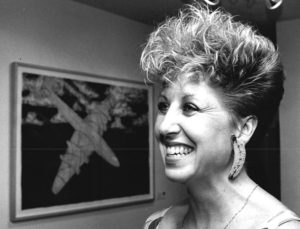
Six years ago, former Weekly staff writer Jimmy Fowler profiled Bill and Pam for a cover story that commemorated the 40th anniversary of their gallery (“The Campbells: Contemporary Classics,” Dec. 2014). Fowler’s reporting at the time included a dutiful summary of the longtime art dealers’ history in Fort Worth.
In 1958, TCU fine arts student Bill Campbell and fashion merchandising major Pam Brazzil, both native North Texans, were introduced by one of Bill’s high school friends at a fraternity party. He talked to her about modern art, and she told him how she’d always wanted to run a retail business. Pam admitted she didn’t know much about contemporary art; he took her to some of his favorite artists’ shows at the Modern, as eager to teach as she was to learn.
They married the next year, shortly before Bill was drafted –– just four days after college graduation –– to serve in the Vietnam War. It was scary but not surprising. Some young men they knew had been drafted, and others had managed to avoid it — but Bill didn’t have any health issues or daddy connections or anything else that would’ve enabled him to get out of service.
Going to war does lots of things to and for people. Characteristically for Bill, one of the things it did was to teach him more about art.
The Army trained him as a helicopter mechanic, and he flew some dangerous missions in Vietnam. During the early months of stateside basic training, though, he was stationed at Fort Mead in Maryland, which allowed him a few visits to the thriving gallery and museum scenes in Washington, D.C., and Baltimore. Direct exposure to those bigger, more diverse art scenes only cemented his desire to bring that quality of work back to North Texas.
“The thing about seeing a lot of really great art is that it makes you expect more,’’ he said. “Dallas had one or two galleries devoted to contemporary art, I think. Fort Worth galleries showed a little bit of it here and there, but they mixed it with Western and Southwestern art and a lot of craft-based work. Remember, this was the late ’60s.”
Bill survived the helicopter missions and everything else during more than two years in Vietnam. When he got out, he and Pam settled in Dallas.
While in college, Bill had helped at the Modern Art Museum of Fort Worth, setting up their contemporary art exhibits. In Dallas, he worked for a commercial art firm, while Pam was employed in various capacities at Neiman Marcus. That company also put her through an executive-management training program that would later be invaluable to running the William Campbell.
Bill lost his job a couple of years later. By then, the couple had a baby son. Feeling fearless, Bill borrowed some money from his dad and leased a small space off Camp Bowie that had housed another gallery. Bill and Pam opened Gallery One there in 1974, the first incarnation of William Campbell Contemporary Art. It was Fort Worth’s first gallery dedicated exclusively to contemporary artists’ work. The Campbells also offered framing and mounting services — and still do.
Margery Gossett, co-owner of another longtime local gallery Artspace 111 said the Campbells deserve credit for building much of the local gallery scene that locals and tourists now enjoy.
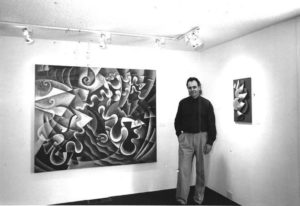
“I was running Artspace111,” Gossett recalled. “Bill and Pam were running the Fort Worth Art Dealers Association, and I served on the executive advisory panel with Bill. It was clear from the start that Bill and Pam were heavily invested in the art scene of Fort Worth and were doing a great job steering the ship. It takes a lot of time and work to put on FWADA’s programming year after year. I will never forget the morning I came in and Bill was sweeping the floor. Often times, people think of the glamorous side of being a gallery owner, but Bill and I just laughed as he sang a song, ‘Oh, the Life of an Art Dealer,’ as he swept out his stall after an exhausting week of 16-hour days. We are so thankful for the path that they have paved for the Fort Worth art scene and for all the hard work that they both put into bringing culture to Cowtown. Our entire Artspace111 team would like to wish the Campbells our best.”
William Campbell Contemporary Art framing manager Vince Veazey credits Bill and Pam with providing him with his current career (and an excuse to move from Tyler, Texas, 10 years ago). The former art teacher said he applied to several galleries across North Texas but dreamed of working at William Campbell Contemporary Art.
“William Campbell was where I hoped to work because I felt the art in the gallery was more enjoyable,” Veazey said.
With his mind set on working at the famed Fort Worth gallery, Veazey turned in his resume. When he didn’t hear back, he turned in his resume a second time. A few weeks later, Veazey decided it wouldn’t hurt to submit his resume a third time.
“After the third time, they hired me for one day to help with an installation,” he recalled. “After a couple weeks, I was hired full-time. A decade has passed, and I’m grateful I put in my resume three times.”
Bill and Pam, he continued, have always put the interests of others ahead of their own and the gallery’s.
“People came first,” he said. “Business was second. They always had a knack for making people feel comfortable even if it was their first time ever in a gallery, which can be an intimidating setting for some. I’m grateful for the example they set, and I hope the contemporary art scene in Fort Worth can continue the momentum the Campbells helped start.”
*****
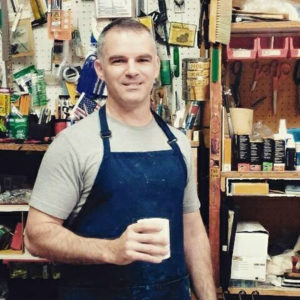
Courtesy of Facebook
Painter Billy Hassell said he met Bill and Pam in the early 1980s and was represented by their gallery by the end of that decade. Having worked with several galleries over his career, Hassell said the Campbells are remarkable — both for their warm and generous personalities and business savvy.
“I can’t say enough great things about them,” he continued. “They are like family. When I moved here 20 years ago, I felt like I had an in” with the community simply because I knew the Campbells.
William Campbell Contemporary Art has always done a good job of blending popular artists with individuals who explore edgier art, he said. The results have been a collection that represents a “wide breadth” of modern art.
When word spread that the Campbells were considering retirement, some artists were worried that the gallery would shut its doors for good, he said.
“I’m excited about the transition,” Hassell said. “It was hard to wrap my head around the Campbells retiring. Peeler and I have had a chance to get to know each other. He has a great personality and good business sense. I think he will be a great [resource] for the future.”
While some represented artists may have anxiety over the transition, Hassell said new blood and new ideas are vital to keeping William Campbell Contemporary Art thriving in the 21st century.
“There is an evolution to any gallery’s client base,” he said. “A lot of the early collectors were all young when Bill and Pam started. Unless you are cultivating new collectors, you will reach a point where it will flatline. The new partners will bring in a whole new generation of collectors.”
William Campbell partner Snodgrass said “younger people are getting into art at a much earlier age. I don’t know if that is due to social media or access to viewing new types of works. I think that we could start to groom younger local art buyers by targeting events that can bring them into the gallery to have a good time in the presence of some great works of art.”
Partner Pate added that the venerable gallery will garner new customers and fans through gallery events that cater to small crowds while following COVID-19-related safety guidelines. Future patrons will likely include interior designers and new home buyers, she said.
The new effort will rely on developing relationships that “connect clients with art that they cannot stop thinking about and that they will enjoy and appreciate forever,” she said.
One immediate benefit of having a team of partners, Howell added, is the expanded number of contacts the gallery now enjoys since the co-owners don’t run in the same circle of friends.
“Each of the five owners is here for a specific reason,” Wilson said, “and the bottom line is that we all love art. These people all care about this business and what we are selling. Everyone has some connection to the community. We want to give Peeler more ideas that he can put on paper. Let him filter those ideas then roll with it.”
Artspace111 gallery manager and painter Ariel Davis said Bill and Pam have been great role models for the local gallery scene.
“They have inspired generations of art lovers in Fort Worth by representing and bringing important artists to Fort Worth,” Davis said. “I will never forget their 40th anniversary party. It was the first time I saw Leon Bridges play, then on a tiny stage, and it was also the day I met my good friend and mentor, Nancy Lamb. I wish Bill and Pam the best in retirement, and I look forward to seeing them at art events at Artspace111 and across Fort Worth.”
Perhaps the Campbells’ most lasting legacy will be the creation of Spring and Fall Gallery Nights, which are organized by the Fort Worth Art Dealers’ Association. FWADA Executive Director Shea Patterson said the Campbells have been the “cornerstone of the gallery community in Fort Worth for many years.
“The quality and consistency of William Campbell Contemporary Art has been so important for Fort Worth’s cultural growth,” Patterson said. “On a personal note, they are professional, entrepreneurial, and generous. They have given of themselves to so many causes in the community. I was lucky enough to get to work with them briefly early in my career and then again as executive director of FWADA for the past 10 years. They both inspired me and taught me so much. Their expertise, kindness, and perseverance are all so evident in the gallery that they have built. Anyone that knows them knows it was a labor of love, and that is reflected by the artists they have supported and all the patrons whose lives they enriched. I am so pleased to call them friends and mentors. Rarely do two people have such a mission.”
Managing relationships with represented artists requires trust, the gallery founders said. The Campbells do not require contractual agreements for represented artists.
“A lot of galleries do” require contracts, Pam said. “For us, it’s always been built on trust. Our artists have become such close friends. They are like close family.”
Bill said the past several weeks have been a mix of melancholy and comfort in knowing that the gallery he co-founded 46 years ago has many decades of life ahead of it. When asked what he will miss the most about the job, he said “the people and the artists.”
Pam nodded in agreement.
“People are thoughtful about the art they collect,” Bill said. “Not that we are superior by any means, but you can talk about art at a higher level [with certain people]. That’s the best part of the whole business. We have met some fabulous people. Peeler and the partners will be introduced to so many more.”



